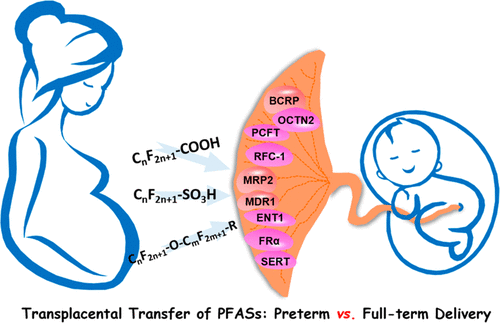当前位置:
X-MOL 学术
›
Environ. Sci. Technol.
›
论文详情
Our official English website, www.x-mol.net, welcomes your
feedback! (Note: you will need to create a separate account there.)
Transplacental Transfer of Per- and Polyfluoroalkyl Substances (PFASs): Differences between Preterm and Full-Term Deliveries and Associations with Placental Transporter mRNA Expression.
Environmental Science & Technology ( IF 10.8 ) Pub Date : 2020-04-01 , DOI: 10.1021/acs.est.0c00829 Jing Li 1 , Dan Cai 2 , Chu Chu 3 , Qingqing Li 3 , Yang Zhou 3 , Liwen Hu 3 , Boyi Yang 3 , Guanghui Dong 3 , Xiaowen Zeng 3 , Da Chen 1
Environmental Science & Technology ( IF 10.8 ) Pub Date : 2020-04-01 , DOI: 10.1021/acs.est.0c00829 Jing Li 1 , Dan Cai 2 , Chu Chu 3 , Qingqing Li 3 , Yang Zhou 3 , Liwen Hu 3 , Boyi Yang 3 , Guanghui Dong 3 , Xiaowen Zeng 3 , Da Chen 1
Affiliation

|
Previous studies demonstrated that per- and polyfluoroalkyl substances (PFASs) can cross the human placental barrier. However, their transplacental transfer efficiencies (TTEs) have not been investigated in preterm delivery, and the role of placental transport proteins has rarely been explored. Our study hypothesized that the TTEs of PFASs could differ between preterm and full-term deliveries, and some placental transporters could be involved in active maternofetal PFAS transfer. In the present study, the median TTEs of 16 individual PFAS chemicals or isomers were determined to be 0.23 to 1.72 in matched maternal-cord serum pairs with preterm delivery (N = 86), which were significantly lower than those (0.35 to 2.26) determined in full-term delivery (N = 187). Significant associations were determined between the TTEs of several PFASs and the mRNA expression levels of selected transporters located on the brush border membrane. The association patterns also significantly differed between preterm and full-term deliveries and exhibited a chemical-specific manner. For example, the expression of MRP2 exhibited significantly positive associations with the TTEs of linear and branched perfluorooctanesulfonic acid (PFOS) isomers in full-term delivery, but negative, nonsignificant associations were observed in preterm delivery. This is the first study to compare the transplacental transfer of PFASs between preterm and full-term deliveries and indicate that some placental transport proteins could be involved in active transmission. The mechanisms underlying the cross-placental transfer of PFASs require further investigations to better elucidate their risks to fetal health and birth outcomes.
中文翻译:

全氟烷基物质和全氟烷基物质(PFAS)的经胎盘转移:早产和足月分娩之间的差异以及与胎盘转运蛋白mRNA表达的关联。
先前的研究表明,全氟烷基物质和多氟烷基物质(PFAS)可以穿越人类胎盘屏障。但是,其胎盘转运效率(TTE)尚未在早产中进行研究,并且很少探讨胎盘转运蛋白的作用。我们的研究假设早产和足月分娩时PFAS的TTE可能有所不同,并且某些胎盘转运蛋白可能参与了主动胎生PFAS的转移。在本研究中,确定的16种PFAS化学品或异构体的TTE的中值在早产(N = 86)的配对母体-脐带血对中为0.23至1.72,显着低于所确定的(0.35至2.26)足月分娩(N = 187)。在几个PFAS的TTE与位于刷状缘膜上的选定转运蛋白的mRNA表达水平之间确定了重要的关联。早产和足月分娩之间的关联模式也存在显着差异,并表现出化学特异性方式。例如,在足月递送中,MRP2的表达与线性和支链全氟辛烷磺酸(PFOS)异构体的TTE呈显着正相关,但在早产中观察到负的,无意义的缔合。这是第一项比较早产和足月分娩之间PFAS跨胎盘转移的研究,并表明某些胎盘转运蛋白可能参与主动传播。
更新日期:2020-04-23
中文翻译:

全氟烷基物质和全氟烷基物质(PFAS)的经胎盘转移:早产和足月分娩之间的差异以及与胎盘转运蛋白mRNA表达的关联。
先前的研究表明,全氟烷基物质和多氟烷基物质(PFAS)可以穿越人类胎盘屏障。但是,其胎盘转运效率(TTE)尚未在早产中进行研究,并且很少探讨胎盘转运蛋白的作用。我们的研究假设早产和足月分娩时PFAS的TTE可能有所不同,并且某些胎盘转运蛋白可能参与了主动胎生PFAS的转移。在本研究中,确定的16种PFAS化学品或异构体的TTE的中值在早产(N = 86)的配对母体-脐带血对中为0.23至1.72,显着低于所确定的(0.35至2.26)足月分娩(N = 187)。在几个PFAS的TTE与位于刷状缘膜上的选定转运蛋白的mRNA表达水平之间确定了重要的关联。早产和足月分娩之间的关联模式也存在显着差异,并表现出化学特异性方式。例如,在足月递送中,MRP2的表达与线性和支链全氟辛烷磺酸(PFOS)异构体的TTE呈显着正相关,但在早产中观察到负的,无意义的缔合。这是第一项比较早产和足月分娩之间PFAS跨胎盘转移的研究,并表明某些胎盘转运蛋白可能参与主动传播。











































 京公网安备 11010802027423号
京公网安备 11010802027423号